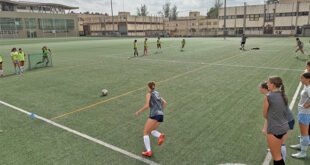“Overall it went very well”
The Crested Butte Mountain Sports Team (CBMST) took a lot of work from parents, teachers, coaches and kids but in the end it appears to be on the right path with big plans in store for the future.
The creation of the program was announced this past summer filling a void left by the closing of the Crested Butte Academy.
Drew Cesati, director of the CBMST, wanted to provide an opportunity for winter sports middle school and high school athletes, i.e. alpine ski racers, snowboarders and freeskiers, to train and compete as well as continue their education.
The CBMST offered three levels of commitment in all three programs with two days a week of training, three days a week of training or a full-time program of six days of training, including a conditioning component.
According to Cesati, the CBMST closed its inaugural winter season hitting a number of its preseason goals.
First, overall participation was solid. Leading into the first year of operation, Cesati was hoping for at least 55 athletes across the board. In the end they had 60.
While a majority of the participants came from the Gunnison Valley, the CBMST also took in athletes from the Front Range, Texas, Telluride and even Sweden.
“A crew of snowboarders started training midseason with us from Telluride,” says Cesati. “I think that’s a testament to the snowboard program and what Christian [Robertson] has done with it.”
The CBMST also hit a number of results-oriented goals, with several of its athletes reaching the pinnacle of their disciplines and everyone making a positive step in their development in their sport.
“As athletes I saw huge gains across the board,” says Cesati.
Individual highlights include Mackenzie Mailly winning the women’s division and Klara Wholers winning the junior women’s division in the U.S. Extreme Freeskiing Telemark Championships. Several CBMST athletes reached the podium at the U.S. Freeskiing Nationals in Snowbird. Six snowboarders and six skiers from the CBMST are currently competing in the U.S. Nationals at Copper Mountain and the alpine racing program had five athletes qualify for the Junior Olympics in their age groups.
“Most of our J3s made it to the Junior Olympics which is an accomplishment in and of itself,” says Cesati.
Ultimately though, the time needed to train and compete conflicted with the school schedule at the Crested Butte Community School. That’s where Peak Education and Consulting and the Crested Butte Community School came in.
“I think that the hours that kids need to train and compete conflict with the traditional school schedule,” says Brian Krill, owner of Peak Education and Consulting.
Krill was the athletic director at the Crested Butte Academy from 1995 to 2001 and is no stranger to the delicate balance of winter sports and education.
Krill and director of student services for Peak Education John Hopper and a staff of tutors worked with the athletes in person, over the phone, online and on the road as well to ensure they remained in step with their course work at the Community School.
“Our role is to be the liaison that enables the kids to succeed academically and athletically,” says Krill.
Looking back on the first year, Krill felt that the partnership worked but needs improvement.
“Overall it went better than expected but it certainly wasn’t perfect,” says Krill. “I can’t thank the teachers and the administration enough. Everybody stepped up to make it work.”
Community School counselor Jennifer Read worked with Krill, the teachers, the student-athletes and the parents throughout the program’s first year.
She echoes Krill’s sentiment.
“Teachers and the school are very supportive of the program,” says Read. “I see the program continuing, with some improvements.”
One improvement involves creating a way for students to earn school credit prior to the winter season next year.
“This summer we’re going to have kids knock off some of their electives,” says Krill. “Taking summer courses is a way to minimize their work load in the winter.”
Another improvement will be in the area of communication. Cesati, Krill and Read all agree; better communication is critical to the program’s success.
“One of the biggest challenges was communication,” says Cesati. “We’re going to launch an effective website. That’s going to be our big push this spring.”
The CBMST has more ideas for the upcoming year. The CBMST looks to offer continued off-season training this summer with a program starting in July, including strength and cardio workouts in conjunction with mountain biking three days a week for kids ages 12 and up.
In addition, the CBMST hopes to find a new clubhouse closer to the slopes for the winter of 2009-2010.
Overall, Cesati believes it was a successful first year for the fledgling program.
“We hit our goals for numbers, we hit our goals for results, now we’re looking ahead to see where we can improve,” says Cesati. “It’s definitely on the up and up.”
 The Crested Butte News Serving the Gunnison Valley since 1999
The Crested Butte News Serving the Gunnison Valley since 1999


